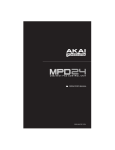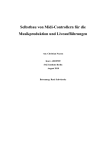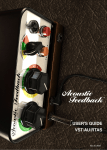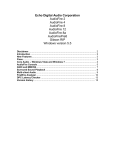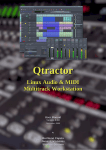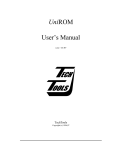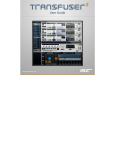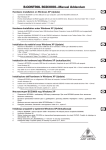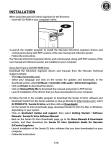Download Mixxx Digital DJ
Transcript
Mixxx Digital DJ Version 1.8.0 User Manual This manual is also available in: • German (Deutsch) • Spanish (Español) www.mixxx.org Copyright© 2010 Mixxx Table of Contents 1. Beginner's Guide 2. Introduction 3. Installation 1. Windows 2. Linux 3. OS X 4. User Interface Overview 1. Playback Controls 2. Tempo Controls 3. Headphone and Flanger 4. Volume and EQ 5. Waveform 6. Waveform Overview 7. End of Track Mode 8. Master and Crossfader Controls 9. Library 5. Configuration 1. Master and Headphone Outputs 2. Latency 3. Samplerates 4. Sound APIs 5. Vinyl Control 6. DJing with Mixxx 1. Loading Tracks 2. Waveform Displays 3. Beatmatching and Mixing 4. Headphone Cueing 7. Keys and Hardware Controllers 1. Keyboard Shortcuts 2. MIDI Controllers 8. Getting Involved 1 Introduction Mixxx is software designed for DJs that allows you to mix songs live. Mixxx natively supports MP3, OGG, FLAC, WAVE, and AIFF playback (with plugins to support additional formats) and can be controlled by numerous DJ MIDI controllers. Turntables with timecoded vinyl can also be used to control Mixxx through the vinyl control feature. Installation Windows Windows users can install Mixxx by double-clicking on the Mixxx installer executable. Mixxx is supported on Windows XP, Vista, and Windows 7, with native 32 and 64 bit versions. (It may also run on Windows 2000.) Linux Linux users can often find Mixxx included with their favourite distribution. For example, Ubuntu users can install Mixxx through the Applications→Add/Remove… menu item. If Mixxx is not packaged for your distribution, you can compile Mixxx from scratch. For details on compiling Mixxx, see: Compiling on Linux OS X OS X (Intel) users can install Mixxx by double-clicking the Mixxx zip archive, and then dragging-and-dropping the Mixxx bundle into their Applications folder. Mixxx requires an Intel Mac running OS 10.4 or newer. 2 User Interface Overview Mixxx's user interface is designed to be simple and easy to use when DJing live. This section outlines the main features of Mixxx's interface. Playback and Hot Cue Controls The playback controls allow you pause, play, and otherwise manipulate the playback of a song. The REV button toggles reverse playback when pressed during regular playback. When playback is stopped, pressing the CUE button places a cue-point at the current position on the waveform. A cuepoint is marked by a white vertical line in the waveform view. If the CUE button is pressed during playback, the song will seek to the cue-point and stop. Holding down the CUE button while the song is positioned on the cue-point will result in the song temporarily playing back, and seeking back to the cuepoint upon release of the CUE button. This describes the “CDJ Mode” cue behaviour, which is modifiable in the preferences under Interface→Default cue behaviour. The Hot Cue buttons allow you to place additional cue-points inside a song, which immediately start playback when triggered. Clicking a Hot Cue button the first time will place a hot cue at the current position in the song, and pressing it again will begin playback from that position. Hot cues are useful for marking different sections of a song for easy access and for manipulating a song. Placing hot cues at the start of different drum sounds in a song allows you to use the Hot Cue buttons as a mini drumkit. Try placing hot cues on different parts of a melody, and use that to remix songs on-the-fly. 3 Tempo and Looping Controls The tempo controls allow you to slow down and speed up a song. This is frequently useful for beatmatching songs when mixing. The RATE slider changes the tempo of a song when it is moved. The PERM buttons apply fine adjustment to the RATE slider, and the TEMP buttons apply a temporary pitchbend when depressed. The amount by which the PERM and TEMP buttons alter the pitch of the track can be changed in the Options→Preferences→Interface menu. The SYNC button attempts to automatically match the tempo of the song in the corresponding channel with tempo of the song in the other channel, based on the calculated BPM. The IN, OUT, and RELOOP/EXIT buttons let you create a loop within a song. The IN button places a starting marker for a loop at the current playback position, and the OUT button places an ending marker and begins looping. The RELOOP/EXIT button is used to break out of a loop if you're in one, or seek back inside the loop if you're outside of it. Loops can be very useful when you're approaching the end of a song, but you don't have the next song ready yet. Try placing a loop in a song's outro during your next mix. See also the SYNC button below. Headphone, Flanger, and Tempo Synchronization When toggled, the HEADPHONE button sends the selected channel's audio to the Headphones output audio device selected in the preferences under Sound Hardware. This feature is commonly used when headphone cueing and beatmatching. The FLANGER button enables a built-in flanger effect on the selected channel. A flanger effect applies a “sweeping” sound to the channel and can add extra depth to a mix when used tactfully. The tempo SYNC button SYNC will change the tempo of the song in the current channel to match the song in the opposite channel. SYNC can be used to beatmatch songs quicker, and is useful for DJs of all skill levels. 4 Volume and EQ The VOL slider controls the volume of the selected channel. The GAIN knob can be used to apply extra amplification to a quiet song, which can be used to match its volume with the song in the other channel. The HIGH, MID, and LOW knobs perform equalization on the channel, reducing or increasing high, mid and low frequencies accordingly. The light at the top of the VU meter indicates when the audio in the selected channel is clipping. If this light goes on, reduce the gain or EQs for this channel to eliminate distortion. Waveform The waveform display shows the loaded tracks' waveforms near the playback position. On songs with certain dynamics, the waveform displays will visibly show the beats in the song. When a cue mark is placed, it is drawn on the waveform as a vertical white line. Clicking and dragging on a waveform allows you to seek through a song. Waveform Overview The waveform overview provides some important information about the song currently loaded in the corresponding channel. From left to right, these are: Track tempo in BPM, current playback position, and track duration. The more interesting part however, is the waveform visualisation of the song, which is useful for seeing breaks or other important changes in the track so that you don't get surprised when they occur while DJing. It also allows you to jump to an arbitrary position in the track by clicking somewhere on the waveform. End of Track Mode The end of track mode determines the Mixxx's behaviour when it reaches the end of a track. The end of track mode is changed by 5 clicking the block to toggle between the three available options; each channel has it's own end of track mode setting that can be changed independently. Stop mode will do nothing further once the end of the track is reached until you load a new track into the channel or seek backwards through the current track. Loop will return to the beginning of the finished track and play it again from the start. Next will automatically load and play the next song in the 'play queue'. Master and Crossfader Controls The crossfader (in the center of the picture) enables you to smoothly fade between the two channels and defines what you hear through the master output. When set all the way to the left, only channel 1 is heard, and set to the right, only channel 2 will be heard. Every position in between gives you the mixed output of both channels. (Note: The actual volume of each channel depends on the crossfader curve, defined in the Crossfader preferences pane.) The Volume and Balance knobs control the volume and the balance (stereo distribution) of the master output. The Pre/Main knob controls what you hear on the headphone output. It works like the crossfader but instead of crossfading between channel 1 and 2, it crossfades between the Master and Cueing signal. If the Pre/Main knob is set to the left, one only hears the cueing signal, which can be useful for prelistening tracks. The HeadVol knob controls the volume of the headphone output. The Depth, Delay and LFO knobs control the flanger. A flanger is an effect that mixes the input signal with a delayed copy of itself which leads to interferences in the signal and creates a comb-filter like effect. By routing the output of the effect back into the input (feedback), this effect can be enhanced. In Mixxx, the volume of the output signal that is routed back into the input can be controlled with the depth knob, which controls the intensity of the effect. The delay knob sets the initial value for the delay length. Inside the effect however, this value is not constant but modulated by an LFO (low frequency oscillator), controllable with the corresponding knob. If this is too technically for you just play around with it and see how the different parameters affect the sound. :) 6 Library The library manages all your music files. This is where you can find the tracks you want to play and load them into a channel. Alternatively, you can also use your external filemanager and drop files onto the waveform display. The sidebar on the left contains different collections of music. The view on the right displays the songs in those collections. The Search box in the top-left the current view for songs that match your query. The Library is displays a sortable list of all the songs in your music library. Mixxx imports your music library automatically when it is run for the first time, and automatically detects newly added songs on each subsequent run. If you want to manually refresh your library without exiting (for example because you added or moved files) you can do this with Library→Rescan Library in the menu. To load a track into a player, you can either simply drag it to the waveform display or use the context menu (right-click on a track). The right-click context menu also allows you to add a track to the Auto DJ queue, playlists, or crates. The Missing Songs view is accessible by expanding Library tree item in the sidebar. Any songs that were previously loaded into your library, but were later detected to be missing from your hard disk by Mixxx will appear here. Mixxx does not automatically delete records of missing songs so that extra metadata Mixxx might have (such as hot cues and the BPM) will not be lost if the file is replaced. The Featured Artists view contains free promotional music that may come bundled with your version of Mixxx. These songs are DJ friendly, and you are licensed to perform live with these songs at any event you'd like. The Auto DJ queue is a special playlist that contains extra controls for enabling 7 automatic mixing. Toggling the “Enable Auto DJ” button within this view will tell Mixxx to automatically load the next song from this playlist when the current song is nearly finished, and crossfade into it. Mixxx will continue to automatically mix until the Auto DJ playlist is empty. Playlists can be created by right-clicking on the “Playlists” sidebar item, and selecting “New Playlist”. Songs can be added to a playlist by finding them in the Library, and drag-and-dropping them onto the name of a playlist in the sidebar, or by selecting a song in the library and right-clicking on it. Playlists are not directly loadable into Mixxx's players as Mixxx is primarily intended for live, attended performance use. However, you can add the contents of a playlist to the Auto DJ queue, and use automatic mixing. Crates are unordered collections of songs, and are similar to playlists. A crate can be created by right-clicking on “Crates” in the sidebar, and selecting “New Crate”. Browse mode works like a file-manager and allows you to load songs that are not necessarily already in your Mixxx library. The Analyze view allows you to see a list of recently added tracks, and to run BPM detection on them in advance. The iTunes (Windows and Mac OS X only) and Rhythmbox (Linux only) views allow you to view the music libraries you have created in 3rd party applications. 8 Configuration The first time Mixxx is started, you are asked to select a directory containing your music library. This directory will be scanned and any music found will be indexed in Mixxx's internal library. The music library path can be changed at any time in the preferences, via the Library and Playlists pane. Mixxx's preferences can be accessed by selecting Options→Preferences. When Mixxx is launched, it tries to select a reasonable sound device for output. You can check which device Mixxx has selected in the Sound Hardware pane in the preferences. Master and Headphone Outputs Mixxx has two audio paths: The Master output and the Headphones output. The Master output is what a DJ should have connected to their main speakers, while the Headphones output should be connected to their personal headphones. The headphone output is optional, and can be used for Headphone Cueing. To configure the Master and Headphones outputs, enter Mixxx's preferences and select the Sound Hardware pane. In order to select a headphone device, either a soundcard with at least 4 channels of output (two stereo outputs, as featured on 5.1 soundcards) or two separate stereo soundcards is required. The output channel mapping, which determines the physical jack on the soundcard that the audio comes out of, can be selected under “Channel”. Example Soundcard Configurations Single audio device (4 Channel Soundcard) Master device: Echo Digital AudioFire4 Headphone device: Echo Digital AudioFire4 Channels: 1/2 Channels: 3/4 Dual audio devices (Two Stereo Soundcards) Master device: ElCheapo USB Audio Headphone device: SoundBlaster Live! Channels: 1/2 Channels: 1/2 Using External Mixers Currently, Mixxx has no special mode for routing the output of a single deck to a separate output, which is what you need when using an external mixer. However, this behaviour can be achieved with a simple trick. Move the crossfader all the way to the left and turn the “Pre/Main” knob all the way left as well. This will give you only the pre-listen signal on the headphone output. Now, enable Cueing for the second channel by toggling channel 2's HEADPHONE button. With this setup, channel 1 will be playing on the master output and channel 2 will be playing on the headphone output. The master and headphone outputs of your soundcard should then be plugged into channel 1 and channel 2 of your external mixer. 9 Latency The latency in Mixxx indicates the amount of time it will take for the audio to respond to any change in a control. For example, a latency of 36 ms indicates that it will take approximately 36 ms for Mixxx to stop the audio after you toggle the play button. Generally speaking, the lower the latency, the more responsive Mixxx will be. A latency between 36-64 ms is acceptable if you are using Mixxx with a keyboard/mouse or a MIDI controller. A latency below 16 ms is recommended when vinyl control is used because Mixxx will feel unresponsive otherwise. In order to tweak your latency, reduce the latency slider in the Sound Hardware preferences pane and experiment until you can reliably run Mixxx without hearing any crackles, pops, or dropouts in the audio. Changing your Sound API to ASIO on Windows or JACK on Linux may allow you to reduce your latency setting, but this depends on your hardware configuration. Keep in mind that lower latencies require better soundcards and faster CPUs and that zero latency DJ software is a myth (although Mixxx is capable of < 10 ms operation). Some tips for reducing latency on linux For detailed information on latency in Linux, you should consult the Web, as it's quite a complex topic. The Jack FAQ is recommended reading, especially the section on “How should I configure my Linux 2.6 Operating System?”. Other useful resources are the Linux Realtime guide and Gentoo's documentation on the subject. The first thing to try if using ALSA is to set your Master output hardware to just “default” instead of specific hardware. (This made a huge difference on a test system with integrated Intel soundcard.) The drawback to this is that system sounds (KDE beeps and such) will now be mixed in and will come out the main output. The second thing one can try to reduce system latency is getting a realtime kernel. If you're using a binary kernel, this might be as simple as installing a realtime enabled kernel with your package manager (if your package system offers one of course). Otherwise download kernel sources and the realtime patch for your kernel version. The patch can be found here. Untar the patch to your kernel source directory, apply it and configure/install the kernel as usual. There are basically two options for configuring the use of realtime-capabilities. The first and simplest one is to use the realtime-lsm modul. This only requires to install the kernel-modul with your package manager. After that you can load it and grant realtime privileges to particular users/groups by setting uid/gid as module options (for example: “modprobe realtime gid=18” gives realtime permissions to the audio group on my system). Unfortunately, this method is deprecated and doesn't work any longer since Linux kernel version 2.6.24). In current kernels you have to use rlimits with PAM to enable realtime priority support. (Note: This is also the prefered method for older 2.6 kernels that might still work with the realtime-lsm modul). To use this method, edit /etc/security/limits.conf : 10 Example: /etc/security/limits.conf * * soft @audio @audio @audio hard rtprio - rtprio - memlock - nice rtprio 0 0 99 unlimited -19 The lines starting with * define default values. The ”@” in @audio tells PAM that audio is a group. One can also set permissions per user by writing it without the ”@”. Another great tip is to use the new BFS scheduler by Con Kolivas. This new scheduler was designed for CPUs with a small number of logical cores (1-16). It gives much lower latencies for these kinds of setups. The FAQ for the BFS Scheduler is at: http://ck.kolivas.org/patches/bfs/bfsfaq.txt. The launchpad page for a PPA by Darxus is at: https://launchpad.net/~darxus/+archive/bfsbfq. Samplerates The soundcard samplerate describes the temporal resolution of its audio. Because most audio tracks are encoded at a samplerate of 44100 Hz, increasing the samplerate inside Mixxx beyond this may not lead to increased audio quality. However, users that still prefer upsampled audio can select a higher sampling rate in the Sound Hardware preferences pane. Keep in mind that increasing the samplerate will increase CPU usage and likely raise the minimum latency you can achieve. Sound APIs Mixxx supports several different Sound APIs across Windows, OS X, and Linux. A Sound API is a tool Mixxx uses to interact with soundcards. Some soundcards come with drivers that are provide lower latency with certain Sound APIs, so different APIs can be selected from Sound Hardware preferences pane. On Windows, ASIO is generally the lowest latency API. On OS X, CoreAudio is the best choice, and on Linux, JACK or ALSA provide the best compatibility and performance. Linux users wishing to use JACK should ensure they run the jackd daemon before launching Mixxx, otherwise JACK will not appear as a Sound API in the preferences. Vinyl Control Vinyl control allows a user to manipulate the playback of a song in Mixxx using a real turntable as a controller. In effect, it simulates the sound and feel of having your digital music collection on vinyl. Many DJs prefer the tactile feel of vinyl, and vinyl control allows that feel to be preserved while retaining the benefits of using digital audio. You can configure vinyl control through the Vinyl Control pane in the preferences. 11 More information about Mixxx's vinyl control and supported hardware configurations is available on the vinyl control wiki page. Input Device Selection Mixxx can be controlled by up to 2 decks with either timecoded vinyl or timecoded CDs. In the “Deck 1” and “Deck 2” drop-down boxes, select the soundcard(s) which your decks are plugged into. In the channel selection dropdown menu, select the channel pairs corresponding to the plug on your soundcard that your deck(s) are plugged into. Mixxx supports vinyl control input through a single soundcard with 4-channels of input (two stereo line-in jacks), or through two separate soundcards which each have 2-channels of input (a single stereo line-in jack). Vinyl control requires the use of stereo line-in jacks - Mono or microphone inputs will not work. Turntable Input Preamp Many turntables provide unamplified “phono level” output, which must be boosted to a “line level” signal. Normally, a mixer provides this amplification, but if you're plugging a turntable's phono output directly into your soundcard, Mixxx can do the amplification. The “Turntable Input Preamp” slider allows you to adjust the level of preamplification applied to your decks' signal. 12 Vinyl Configuration Several different types of time-coded media can be used to control Mixxx. Configure the “Vinyl Type” drop-down menu to match what type of time-coded vinyl or CD you are using on your deck(s). The “Lead-in Time” setting allows you to set a dead-zone at the start of your vinyl or CD, where the time code will be ignored. This is useful in situations where the time code begins very close to the edge of a vinyl, which can make back-cueing over the first beat in a song tricky to do without your turntable's needle falling off the vinyl. Setting a lead-in time of 20 seconds or more helps alleviate this by giving you more room on the vinyl to cue with. It's also useful when you've worn the grooves at the edge of a control record to the point that it no longer works reliably: you simply set the lead-in so that the start of the songs begin in good groove area. You can keep doing this until you run out of groove area, thereby decreasing your record replacement frequency. Control Mode Mixxx supports three control types on all of the timecodes we support. “Absolute Mode” provides Mixxx with both pitch and position information from the timecode, and allows you to seek by needle dropping on your vinyl or seeking on your CDJ. “Relative Mode” takes the position to be relative to your deck's starting point, and only controls the pitch in Mixxx. It is not possible to seek using your deck in relative mode. “Scratch Mode” is an enhanced version of relative mode, and only applies to FinalScratch vinyl. Scratch mode improves performance slightly while scratching, but is not necessary for better performing timecodes like Serato. Finally, “Needle-skip Prevention” allows Mixxx to detect and ignore small changes in needle position, such as when you've accidentally bumped your turntable. This can be advantageous in a live performance environment, but the downside is that it reduces responsiveness during scratching. Consequently, disabling needle-skip prevention is recommended for scratch performances. Signal Quality A successful vinyl control setup hinges on good signal quality. Many factors can affect signal quality, but the most important one is ensuring the volume level of your timecode signal is moderate. A signal that is too loud or too quiet will cause adverse performance, often characterized by a loss of position data causing absolute mode to behave like relative mode. For more information on improving signal quality and troubleshooting, please see the vinyl control wiki page. Mixxx represents your timecode signal quality as a pair of real-time bar graphs. The two graphs correspond to your “Deck 1” and “Deck 2” input devices. The left-most column in each graph represents the overall status of the timecode signal. A full bar with an “OK!” indicates everything is working well. The latter two columns in the graph represent the raw, unprocessed stereo signal coming from your decks. A good signal will appear as a pair of fluctuating green bars, each of which will be out of phase. Red bars indicate the volume is too low or 13 two high, and the “Turntable Input Preamp” setting can be adjusted to boost the volume. 14 DJing with Mixxx Mixxx was designed to be easy to learn for both novice and experienced DJs. The user interface mimics a hardware DJ mixer, but also includes several extra elements to gives DJs a better user experience, such as the parallel waveform displays. Loading tracks Songs can be loaded into a player in several ways: • Right-click the library track table: Right-clicking on a track in the table will present the options “Load in Player 1” and “Load in Player 2”, among others. Making either selection will load a track into a player. • Drag-and-drop from library track table: Dragging-and-dropping a song from the track table onto a waveform display will load a track into a player. • Drag-and-drop from external file browser: Dragging-and-dropping a song from an external file browser directly onto a waveform display in Mixxx will load that song. This function is also known to work on some platforms with other applications. For example, on OS X, dragging-and-dropping a track from iTunes onto one of Mixxx's waveform displays will load that song into a player. Waveform displays There are two main waveform displays in Mixxx that are used to display the waveform of the songs you are mixing. These are useful because they allow you to see features in a song (like a breakdown) before you hear them. The waveform displays are aligned parallel to each other in order to make beat matching easier, as it is possible to beatmatch visually by aligning the beats that appear in each waveform. Clicking and dragging on a waveform allows you to seek through a song in both directions. The waveform display is updated in realtime upon seeking. There are two smaller waveform summary displays located adjacent to the main waveform displays. These smaller displays show the waveform envelope of the entire song, and are useful because they allow DJs to see breakdowns far in advance. Vinyl DJs will find this familiar because quiet sections of songs can be visually distinguished when looking at a vinyl record, and this is a useful tool when planning your mixes on-the-fly. Beatmatching and Mixing Beatmatching is the process of adjusting the playback rate of a song so that it matches the tempo of another song. Beatmatching also involves adjusting the phase of the beats in a song so that they are aligned with the beats in the other song. Matching the tempo and aligning the beats are the two things a DJ must do to beatmatch. 15 In Mixxx, you can match the tempo of two songs by adjusting the playback rate sliders on left and right side of the user interface. You can adjust the phase of the beats by clicking-and-dragging on either waveform display to temporarily slow down one of the songs until the beats are aligned. The temporary pitch bend buttons can also be used to momentarily adjust the playback rate, allowing you to “shuffle” the beats in a song forwards or backwards, so they can be aligned with another song. Once the tempos are matched and the beats aligned between two songs, they are said to be beatmatched. A “perfect” beatmatch is near impossible - there will always be some tiny difference in the playback rates. A keen DJ will keep his or her ears open and listen for the beats drifting out of alignment. This has a distinct “double bass kick” sound which is often preceded by the kick weakening in intensity (as the two kicks drift out of phase). When this happens, the beats can be realigned by simply tapping one of the temporary pitch bend buttons a few times in the appropriate direction. Now get out there and make Tiesto jealous! Headphone Cueing Headphone cueing is a technique DJs use to listen to the next track they want to play in their headphones before playing it out the main speakers. Mixxx allows a DJ to route audio from either player to their headphones by toggling either of the “HEADPHONE” buttons located on the far left/right sides of Mixxx's interface. Headphone cueing is useful because it allows a DJ to beatmatch the next song in their headphones before bringing it into their mix by sliding the crossfader. Recording your mix You can record Mixxx's master output in real time to an uncompressed linear PCM WAV (RIFF) sound file by doing the following: 1. On the menu bar, click “Options” 2. Click “Record Mix” 3. Choose where to save it and what to call it then click OK 4. Mixxx will then wait until you start playing some music before it begins recording. The recording will begin about two seconds after that. (If you want it to get your first sounds, just press Play then Cue (or Pause) to start it, then begin mixing two seconds later. You can remove the initial silence with an audio editing program like Audacity after you finish mixing.) 16 Keyboard and MIDI Controllers Keyboard Shortcuts Function Crossfade Left Crossfade Right Playback Set Cuepoint Seek Backwards Reverse Playback Seek Forwards Cue Cue Go-to-and-stop Tempo (BPM) Sync Tempo Adjust Down Tempo Adjust Up Small Tempo Adjust Down Small Tempo Adjust Up Temporary Tempo Adjust Down Temporary Tempo Adjust Up Small Temporary Tempo Adjust Down Small Temporary Tempo Adjust Up Headphone Cue (PFL) Low EQ Kill Mid EQ Kill High EQ Kill Flanger BPM Tap Tempo Adjust Hotcue 1 Hotcue 2 Hotcue 3 Hotcue 4 Clear Hotcue 1 Clear Hotcue 2 Clear Hotcue 3 Clear Hotcue 4 Deck 1 Deck 2 Master H G D Shift+D A Shift+A S E Shift+E 1 F1 F2 Shift+F1 L Shift+L J Shift+J K O Shift+O 0 F5 F6 Shift+F5 Shift+F2 F3 Shift+F6 F7 F4 F8 Shift+F3 Shift+F7 Shift+F4 Shift+F8 T 5 4 3 2 Q Z X C V Shift+Z Shift+X Shift+C Shift+V Y 6 7 8 9 U M , . / Shift+M Shift+< Shift+> Shift+? 17 Quick Reference Printable (large) keyboard reference sheet Customizing The shortcuts are defined in a text file, and can be changed by the user Linux: /usr/share/mixxx/keyboard/Standard.kbd.cfg MacOS X: <Mixxx bundle>/keyboard/Standard.kbd.cfg Windows: <Mixxx directory>\keyboard\Standard.kbd.cfg MIDI Controllers MIDI controllers are external hardware devices used that can be used to control audio applications, like Mixxx. Many DJs prefer the “hands-on” feel of a MIDI controller with Mixxx because it can feel similar to using a real mixer and turntables. Mixxx can work with any MIDI controller that has drivers for your OS, as long as there is a MIDI mapping file to tell Mixxx how to understand it. Mixxx comes bundled with a number of MIDI mapping presets for the devices listed below. Often times these mappings are contributed by users, but the Mixxx team has no way of judging the quality of the mappings because we don't own the devices ourselves. There are two different levels of support for devices in Mixxx: Mixxx Certified Support and Community Support. Mixxx Certified mappings are verified by the Mixxx Team. Community Supported mappings are mappings provided by the Mixxx Community, but the Mixxx team is unable the verify their quality. Mixxx Certified Mappings • Hercules DJ Console RMX • Hercules DJ Console MK2 • Hercules DJ Control MP3 e2 18 • Stanton SCS.3d • Stanton SCS.3m • Stanton SCS.1m • M-Audio X-Session Pro • DJ TechTools MIDIFighter Community Supported Mappings These mappings have been verified as working by the Mixxx community. However, they might have bugs or rough edges. If you run into issues with these mappings, please file a bug on our bug tracker or tell us about it on our mailing list, forums, or IRC channel. • Hercules DJ Console MP3 • Hercules DJ Control Steel • Hercules DJ Console Mac Edition • Mixman DM2 • Tascam US-428 • M-Audio Xponent • Evolution X-Session • Ecler NUO4 • FaderFox DJ2 • Vestax VCI-100 • Numark Total Control • Behringer BCD3000 • Akai MPD24 Before purchasing a controller to use with Mixxx, please consult our Hardware Compatibility wiki page. It contains the most up-to-date documentation on which controllers work with Mixxx and what the caveats of each device are. Device support varies for each supported OS, so please make sure to consult the documentation. 19 Getting Involved Mixxx is a community-driven project involving many DJs worldwide. Without the contributions from these DJs, Mixxx would not exist, and we're constantly looking for more contributors. If you're interested in getting involved with Mixxx, send our Developer's Mailing List an email or hop on our IRC channel (#mixxx on Freenode). If you're interested in coding (C++): • Take a look at our specs/projects page on the Mixxx Wiki and see if anything catches your eye. If you want to start coding one of these, go right ahead! • We're always willing to mentor and help out new coders • Take a look at our bug tracker, try to fix a bug! • Send patches to mixxx-devel or post them as bugs on Launchpad! If you're not interested in coding, there are still many ways to help our project: • Test beta and trunk versions of Mixxx to make sure new features and fixes work well in all cases. • Create mappings for MIDI controllers Mixxx doesn't yet support. (Advanced functionality requires some Javascript-like programming.) • Help answer questions in the forum. • Help promote Mixxx - If you've got a blog, write an article about Mixxx. Blog about our new releases when they come out. Any exposure on the web and in print helps our project grow, and is much appreciated. • Send us some photos of you using Mixxx at a gig! 20






















